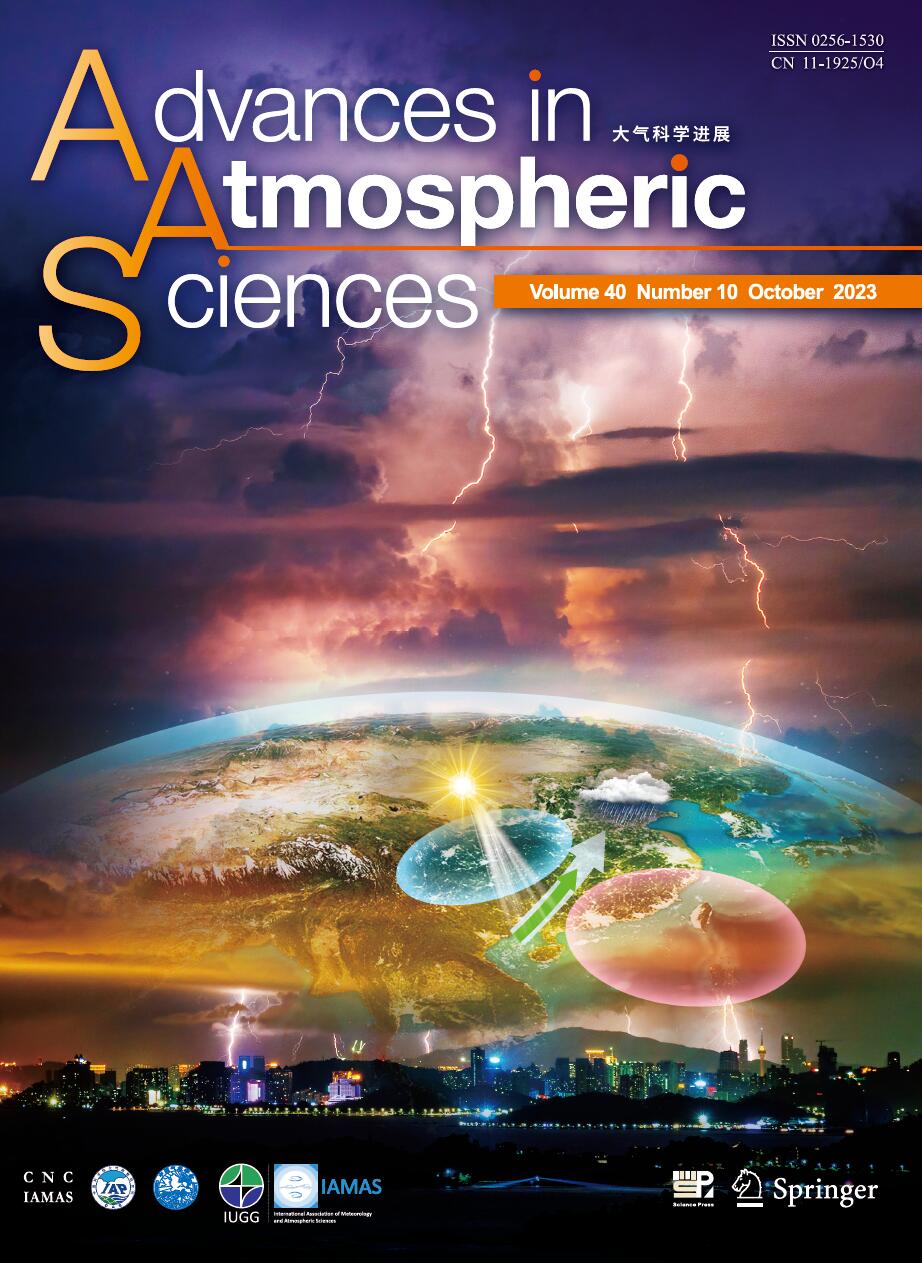| [1] |
LI Shan, RONG Xingyao, LIU Yun, LIU Zhengyu, Klaus FRAEDRICH,
2013: Dynamic Analogue Initialization for Ensemble Forecasting, ADVANCES IN ATMOSPHERIC SCIENCES, 30, 1406-1420.
doi: 10.1007/s00376-012-2244-z
|
| [2] |
Jiangshan ZHU, Fanyou KONG, Xiao-Ming HU, Yan GUO, Lingkun RAN, Hengchi LEI,
2018: Impact of Soil Moisture Uncertainty on Summertime Short-range Ensemble Forecasts, ADVANCES IN ATMOSPHERIC SCIENCES, 35, 839-852.
doi: 10.1007/s00376-017-7107-1
|
| [3] |
Se-Hwan YANG, LI Chaofan, and LU Riyu,
2014: Predictability of Winter Rainfall in South China as Demonstrated by the Coupled Models of ENSEMBLES, ADVANCES IN ATMOSPHERIC SCIENCES, 31, 779-786.
doi: 10.1007/s00376-013-3172-2
|
| [4] |
BEI Naifang, Fuqing ZHANG,
2014: Mesoscale Predictability of Moist Baroclinic Waves: Variable and Scale-dependent Error Growth, ADVANCES IN ATMOSPHERIC SCIENCES, 31, 995-1008.
doi: 10.1007/s00376-014-3191-7
|
| [5] |
SONG Xiang and ZENG Xiaodong*, ,
2014: Investigation of Uncertainties of Establishment Schemes in Dynamic Global Vegetation Models, ADVANCES IN ATMOSPHERIC SCIENCES, 31, 85-94.
doi: 10.1007/s00376-013-3031-1
|
| [6] |
Feifan ZHOU, Wansuo DUAN, He ZHANG, Munehiko YAMAGUCHI,
2018: Possible Sources of Forecast Errors Generated by the Global/Regional Assimilation and Prediction System for Landfalling Tropical Cyclones. Part II: Model Uncertainty, ADVANCES IN ATMOSPHERIC SCIENCES, 35, 1277-1290.
doi: 10.1007/s00376-018-7095-9
|
| [7] |
Ruiqiang DING, Baojia LIU, Bin GU, Jianping LI, Xuan LI,
2019: Predictability of Ensemble Forecasting Estimated Using the Kullback-Leibler Divergence in the Lorenz Model, ADVANCES IN ATMOSPHERIC SCIENCES, , 837-846.
doi: 10.1007/s00376-019-9034-9
|
| [8] |
ZHU Jiang, LIN Caiyan, WANG Zifa,
2009: Dust Storm Ensemble Forecast Experiments in East Asia, ADVANCES IN ATMOSPHERIC SCIENCES, 26, 1053-1070.
doi: 10.1007/s00376-009-8218-0
|
| [9] |
T. N. Krishnamurti, Mukul Tewari, Ed Bensman, Wei Han, Zhan Zhang, William K. M. Lau,
1999: An Ensemble Forecast of the South China Sea Monsoon, ADVANCES IN ATMOSPHERIC SCIENCES, 16, 159-182.
doi: 10.1007/BF02973080
|
| [10] |
Chenxi WANG, Zhihua ZENG, Ming YING,
2020: Uncertainty in Tropical Cyclone Intensity Predictions due to Uncertainty in Initial Conditions, ADVANCES IN ATMOSPHERIC SCIENCES, 37, 278-290.
doi: 10.1007/s00376-019-9126-6
|
| [11] |
Jianguo LIU, Binghao JIA, Zhenghui XIE, Chunxiang SHI,
2016: Ensemble Simulation of Land Evapotranspiration in China Based on a Multi-Forcing and Multi-Model Approach, ADVANCES IN ATMOSPHERIC SCIENCES, 33, 673-684.
doi: 10.1007/s00376-016-5213-0
|
| [12] |
WANG Huijun, FAN Ke, SUN Jianqi, LI Shuanglin, LIN Zhaohui, ZHOU Guangqing, CHEN Lijuan, LANG Xianmei, LI Fang, ZHU Yali, CHEN Hong, ZHENG Fei,
2015: A Review of Seasonal Climate Prediction Research in China, ADVANCES IN ATMOSPHERIC SCIENCES, 32, 149-168.
doi: 10.1007/s00376-014-0016-7
|
| [13] |
HU Shujuan, CHOU Jifan,
2004: Uncertainty of the Numerical Solution of a Nonlinear System's Long-term Behavior and Global Convergence of the Numerical Pattern, ADVANCES IN ATMOSPHERIC SCIENCES, 21, 767-774.
doi: 10.1007/BF02916373
|
| [14] |
Deliang CHEN, Christine ACHBERGER, Jouni R¨AIS¨ANEN, Cecilia HELLSTR¨OM,
2006: Using Statistical Downscaling to Quantify the GCM-Related Uncertainty in Regional Climate Change Scenarios: A Case Study of Swedish Precipitation, ADVANCES IN ATMOSPHERIC SCIENCES, 23, 54-60.
doi: 10.1007/s00376-006-0006-5
|
| [15] |
Chengjun XIE, Tongwen WU, Jie ZHANG, Kalli FURTADO, Yumeng ZHOU, Yanwu ZHANG, Fanghua WU, Weihua JIE, He ZHAO, Mengzhe ZHENG,
2023: Spatial Inhomogeneity of Atmospheric CO2 Concentration and Its Uncertainty in CMIP6 Earth System Models, ADVANCES IN ATMOSPHERIC SCIENCES, 40, 2108-2126.
doi: 10.1007/s00376-023-2294-4
|
| [16] |
Zhenhua HUO, Wansuo DUAN, Feifan ZHOU,
2019: Ensemble Forecasts of Tropical Cyclone Track with Orthogonal Conditional Nonlinear Optimal Perturbations, ADVANCES IN ATMOSPHERIC SCIENCES, 36, 231-247.
doi: 10.1007/s00376-018-8001-1
|
| [17] |
Saleh AMINYAVARI, Bahram SAGHAFIAN, Majid DELAVAR,
2018: Evaluation of TIGGE Ensemble Forecasts of Precipitation in Distinct Climate Regions in Iran, ADVANCES IN ATMOSPHERIC SCIENCES, 35, 457-468.
doi: 10.1007/s00376-017-7082-6
|
| [18] |
Jihang LI, Zhiyan ZHANG, Lu LIU, Xubin ZHANG, Jingxuan QU, Qilin WAN,
2021: The Simulation of Five Tropical Cyclones by Sample Optimization of Ensemble Forecasting Based on the Observed Track and Intensity, ADVANCES IN ATMOSPHERIC SCIENCES, 38, 1763-1777.
doi: 10.1007/s00376-021-0353-2
|
| [19] |
XU Hui, DUAN Wansuo,
2008: What Kind of Initial Errors Cause the Severest Prediction Uncertainty of El Nino in Zebiak-Cane Model, ADVANCES IN ATMOSPHERIC SCIENCES, 25, 577-584.
doi: 10.1007/s00376-008-0577-4
|
| [20] |
Yunyun LIU, Zeng-Zhen HU, Renguang WU, Xing YUAN,
2022: Causes and Predictability of the 2021 Spring Southwestern China Severe Drought, ADVANCES IN ATMOSPHERIC SCIENCES, 39, 1766-1776.
doi: 10.1007/s00376-022-1428-4
|















 AAS Website
AAS Website 
 AAS WeChat
AAS WeChat 
 DownLoad:
DownLoad: